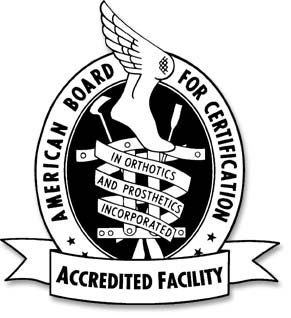Q: I had an amputation, now what?
A: Call us to set up a free consultation. We will guide you in the right direction. Keep in mind that a prosthetic device will never feel or act exactly like your own limb, however, your prosthetic device will help you do many of the things you need to do quite effectively. As such, You will need to put time and energy into learning how to use it. A smooth transition will include working with your therapist and training with it.
Q: What does a prosthetic device look like and how is it attached?
A: One prosthesis can look totally different from another prosthesis depending on the manufacturer or type of amputation that it has been fitted for. Prosthetic devices are attached to a socket which connects to the part of the body that has been amputated. Prosthetic cosmetics are available that help mask the fact that the patient is actually wearing a prosthesis.
Q: How long will it be before I can start to do most of the things I did before the amputation?
A: For most people, with correct training and a can-do attitude, it should take at least 3 to several months depending on the location of the amputation and your overall physical ability.
Q: When will I get a prosthesis?
A: Often the fitting is done just a few weeks after surgery. When the wound has healed and the swelling has subsided.
Q: What is the life of a prosthetic device?
A: Depending on your age (growth level) and activity level, a prosthesis can last anywhere from several months to several years. Early on, usually just after limb loss, shrinkage of the limb can occur. This may require socket changes, the addition of a liner and even a different device. Later, an increased activity level or desire for additional function of the prosthesis will require new parts or a change of prosthesis altogether. Once you are comfortable with the fitting and are functioning at your desired activity level, the prosthesis needs only minor repairs or maintenance that can last for years.
Q: Will I still need to use an assistive device such as a wheelchair or crutches?
A: Most amputees will use crutches for times when the limb is off, this includes night time trips to the bathroom, showering etc.. If you are an amputee who has lost both legs, you will probably use a wheelchair at least some of the time.
Q: Once I have been fitted and feel comfortable in its function, what will happen next?
A: Plan on making follow-up visits. Proper fit of the socket and good alignment will insure that the prosthesis continues to function properly for you. Prosthesis, as with many things, need regular maintenance and repair to continue to function correctly. Small adjustments to your TLNB custom orthotics can make all the difference.
Q: Can my prosthetic limb break down?
A: Yes, eventually your device will require repair or replacement, so be sure to ask us about warranties and what to expect from your insurance company. Always come in to have your prosthesis repaired no matter how small the damage. This will prevent it from breaking further which can save you money and potentially protect your body from harm. Depending on where the prosthetic device is damaged, it may also cause harm to your body. So it is best to call right away to make an appointment and ask questions about it early on to prevent any further damage to the unit or to your body or both.

